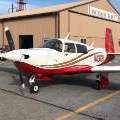I'm a little confused about how RPM affects fuel saving and efficiency when LOP.
While ROP, using lower RPM with higher MP (if available) yields a reduction of fuel flow (albeit at the cost of speed but fuel flow seems to win over amount of speed loss). For example from the POH for 2000ft all of the following yield 75% power:
2700RPM, 23.3", 10.8GPH
2600RPM, 24.4", 10.5GPH
2400RPM, 26.8", 10.3GPH
According to the POH speed is identical across all settings which is a strong justification for reducing RPM when MP is available. In practice it seems that speed suffers a tiny bit but not substantially (getting into the lower 2000s).
Now my question is how to pick RPM for LOP operations? If we're leaning lean of peak and controlling power with mixture, then what kind of gas saving role does lower RPM provide? Being at a higher RPM, you'll still be leaning to a target fuel flow (say 10GPH for 75% in 201) so it doesn't seem to affect gas savings what RPM you're at like it would when ROP (although it may change how far LOP you can get and affect cooling). So what is the method for selecting an optimal RPM setting to use for LOP operations and how does this vary by altitude?

